
Espaguetis a la Amatriciana
Compartir
Spaghetti all'Amatriciana
Rated 5.0 stars by 1 users
Category
Pasta
Cuisine
Italian
Servings
6
Prep Time
20 minutes
Cook Time
10 minutes
Amatriciana is a famous pasta recipe in Roman trattorias and restaurants. Because of this, many people think it’s a dish that was created in Rome. Actually, the recipe has its origins in Amatrice (hence the name), a small town in the Rieti area.
Amatriciana recipe consists of pasta – bucatini or spaghetti – tossed with the classic Amatriciana sauce made with peeled tomatoes, guanciale, chili peppers and pecorino romano cheese. Other ingredients, such as garlic and onion, are not present in the authentic recipe from the town of Amatrice, but you will find them in the Roman variant.
Also with regard to pasta, the Roman recipe uses bucatini, while in the authentic Amatriciana recipe you will have spaghetti.
Wanting to respect the traditional recipe of pasta all’Amatriciana (or Matriciana as they call it in Rome), in this recipe we’ll just use spaghetti, pecorino romano, guanciale, chilli pepper and peeled tomatoes.
According to tradition, remember that the right ratio of guanciale to pasta is one-fourth: therefore, for 500 g (1,1 pound) of pasta, you need 125 g (1/4 pound or 4,4 oz) of guanciale.
Some prefer to sauté the guanciale for a few minutes and then add white wine. White wine is listed as an ingredient but is optional; it’s not essential to the success of the recipe, so it depends on taste.
Along with pasta carbonara and cacio e pepe, amatriciana, although a typical recipe from Lazio, has become a classic of Italian cuisine.
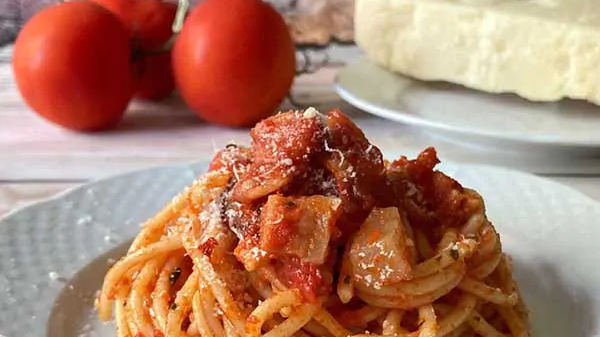
Ingredients
-
125 g (4,4 oz) of guanciale
-
320 g (about 2 cups) of Paolo Petrilli’s Organic Peeled Tomatoes.
- 1 chili pepper
- 50 ml (1/4 cup) of dry white wine (optional)
-
Coarse Sea Salt
-
400 g of Spaghetti alla Chitarra
-
80 g (2/3 cup) of grated Pecorino Romano.
Directions
Step 1) – To prepare the amatriciana sauce, get a fairly large frying pan. First cut the guanciale into strips. Then put the chili pepper in the pan and add the guanciale.
The dark meat of the guanciale, which you see in the picture, is rich in pepper and spices and should not be thrown away. It gives the sauce a very tasty flavor, so keep it.
As you may have already guessed, you don’t need oil in this recipe. If, however, instead of guanciale you are using bacon, which is leaner, add a tablespoon of oil, as suggested in the paragraph below on variations of amatriciana sauce.
Step 2) – Sauté the guanciale, turning it often with a wooden spoon, until the white fat part has become transparent and golden (about 5 min).
Now is the time to add the white wine (optional). Keep the high heat and let it evaporate
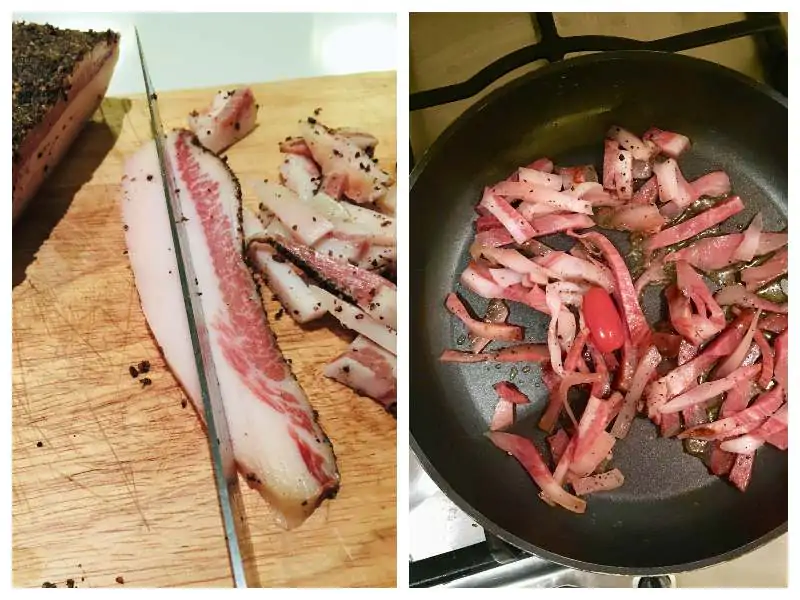
Step 3) – Meantime prepare the peeled tomatoes. We recommend Paolo Petrilli’s Organic Peeled Tomatoes which are considered by many to be the best peeled tomatoes on the market.
Add the peeled tomatoes with their sauce.
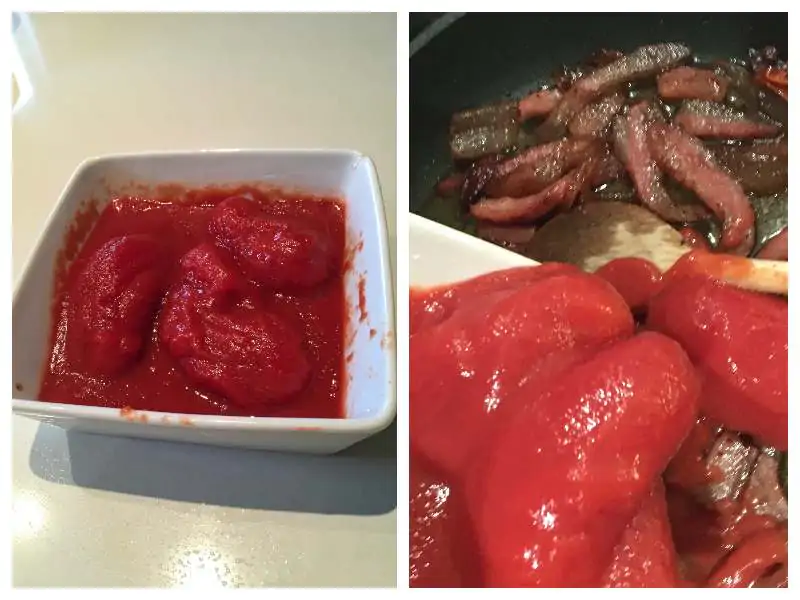
Step 4) – With the help of a fork, crush the tomatoes so that they become pulpy. Stir and add a pinch of fine salt to taste. Cook Amatriciana sauce for 10 minutes on medium heat. When the sauce is ready, remove the chili pepper.
Amatriciana Sauce is Ready! Now let’s see how to make pasta all’Amatriciana.
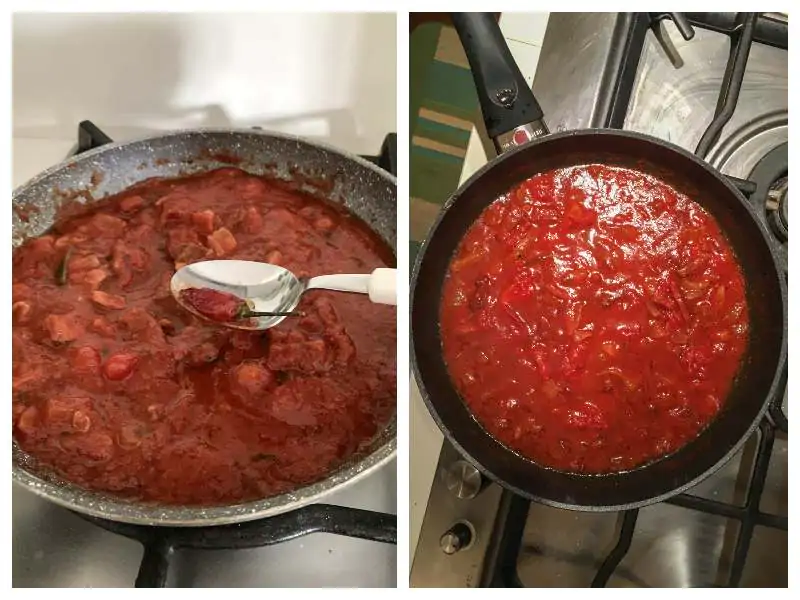
Step 5) – Meanwhile, cook spaghetti in plenty of salted water water. If you are using coarse sea salt we recommend 0.6 oz per quart (1.6 oz per gallon) of water.
Drain spaghetti al dente and pour them into the pan with Amatriciana sauce.
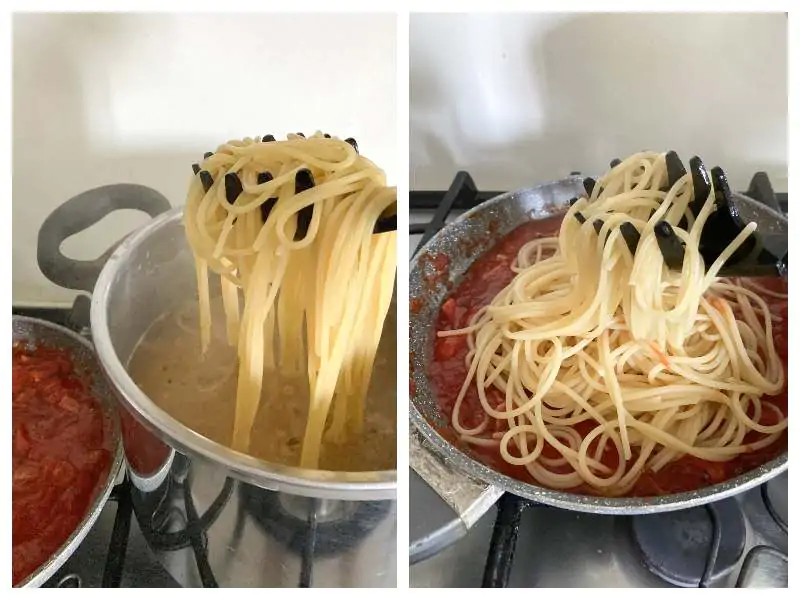
Step 6) – Stir and add grated Pecorino Romano which will bind all the ingredients.
Authentic Italian Amatriciana is ready! Serve very hot with a further sprinkling of Pecorino Romano.

Recipe Note
Every traditional recipe has many variations, and this happens also for this traditional recipe of pasta Amatriciana, in which the variations are characterized by the addition or replacement of the ingredients according to the traditions of the different Italian regions or simply to your tastes.
Gricia
Many people like cooking Amatriciana sauce without tomatoes. This dish in Italy is called Pasta alla Gricia or Griscia from the name of Grisciano, a village near Amatrice. For more information check out our recipe “Pasta alla Gricia”.
